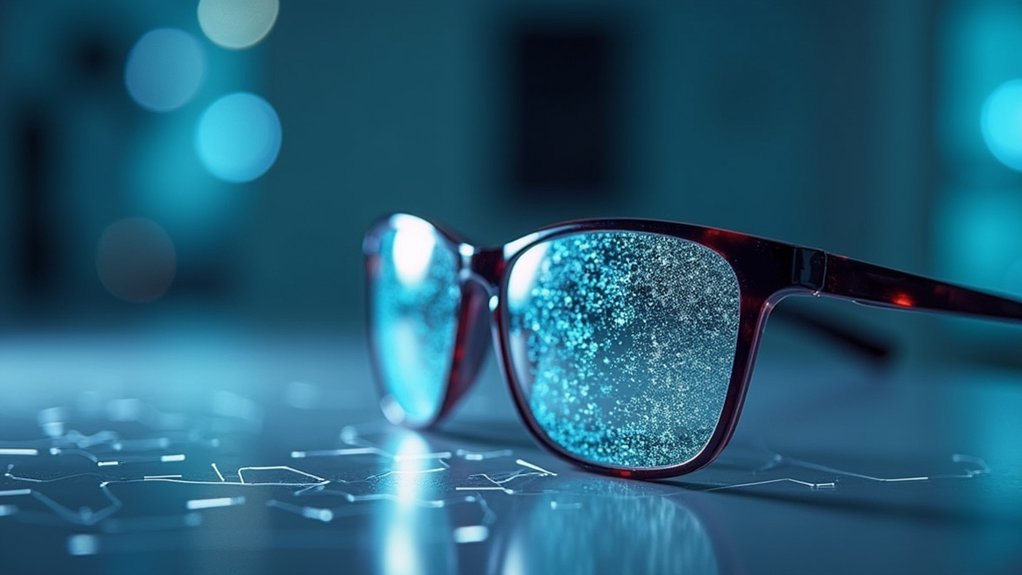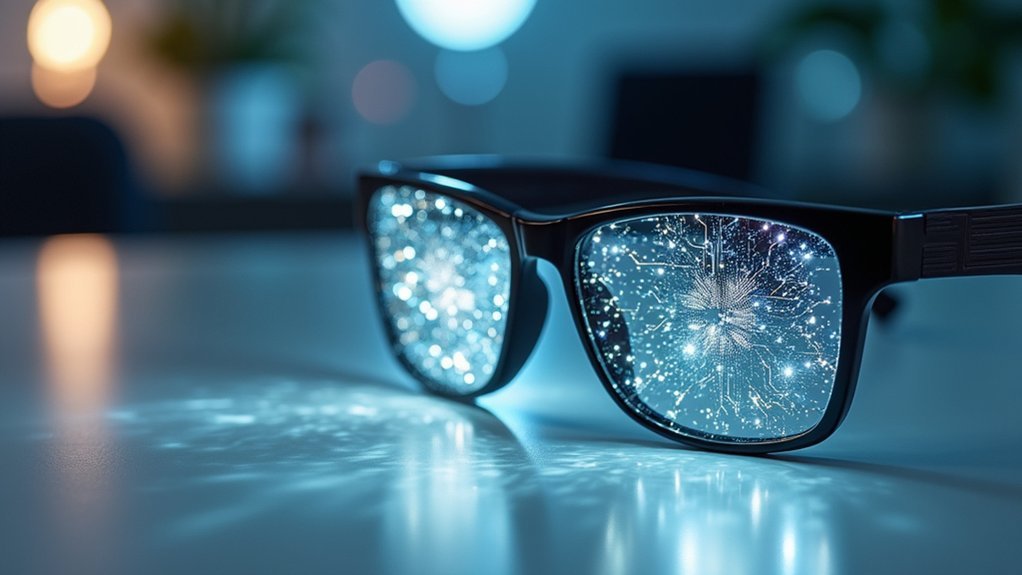When advanced eye tracking technology meets prescription lenses, you’ll experience revolutionary vision correction that goes beyond traditional methods. This technology detects misalignments as small as 0.01 Prism Diopters and captures over 10,000 data points during your examination to create personalized solutions like Neurolens®. Your prescription becomes dynamically tailored to your unique eye-brain coordination patterns, offering real-time adjustments for varying lighting conditions and distances. Discover how this fusion transforms your visual comfort completely.
The Evolution of Eye Tracking Technology in Vision Correction

Over the past decade, eye tracking technology has revolutionized how eye care professionals measure and correct vision problems.
You’ll now benefit from systems that detect misalignments as small as 0.01 Prism Diopters, providing unprecedented precision in vision assessment. Your eye care provider captures over 10,000 data points during examination, creating an extensive map of your unique visual needs.
This technological advancement represents a dramatic shift from traditional prescription methods that often missed underlying issues.
Modern eye tracking systems analyze your eye-brain connection, optimizing depth perception and binocularity for enhanced visual function. You’re no longer limited to standard corrective lenses that address only basic refractive errors.
Eye tracking technology transforms vision correction by analyzing your unique eye-brain connection beyond standard refractive errors.
Instead, personalized solutions like Neurolens® use this detailed eye tracking data to create therapeutic lenses tailored specifically to your individual visual requirements.
How Advanced Sensors Revolutionize Prescription Lens Design
You’ll find that precision eye movement mapping transforms how optometrists create your prescription lenses by capturing thousands of micro-movements your eyes make throughout the day.
Advanced sensors now detect misalignments as tiny as 0.01 Prism Diopters, allowing customized lens calibration systems to address visual issues you mightn’t even realize you’re experiencing.
These sophisticated measurements enable your eye care provider to design lenses that work specifically with your unique eye-brain coordination patterns.
Precision Eye Movement Mapping
Advanced sensors now capture more than 10,000 data points from your eye movements, measuring misalignments as precise as 0.01 Prism Diopters to revolutionize how prescription lenses are designed.
This advanced eye-tracking technology transforms traditional vision correction by creating an extensive map of how your eyes actually move and function together.
The precision mapping process analyzes your unique visual patterns, tracking micro-movements that standard eye exams can’t detect. These detailed measurements reveal exactly how your eyes coordinate during reading, focusing, and tracking objects.
The data enables optometrists to design lenses that work with your natural eye movements rather than against them.
This personalized approach directly impacts your eye health by reducing strain and fatigue. Your customized lenses optimize eye-brain interaction, improving clarity while supporting better depth perception and visual comfort throughout daily activities.
Customized Lens Calibration Systems
Calibration precision transforms raw eye-tracking data into therapeutic solutions that address your specific visual challenges.
Customized lens calibration systems capture over 10,000 data points from your eyes, detecting even the smallest 0.01 Prism Diopter misalignments that cause headaches and strain.
These advanced sensors revolutionize prescription lens design through:
- Precise alignment detection – Identifies microscopic eye misalignment patterns affecting your comfort
- Dynamic viewing optimization – Adjusts lens angles for real-world visual tasks
- Enhanced eye-brain connection – Improves neural processing of visual information
- Therapeutic intervention targeting – Creates specific solutions for your discomfort symptoms
You’ll experience markedly improved visual clarity as these systems optimize every aspect of your lens prescription, ensuring your lenses work harmoniously with your unique eye movement patterns and visual requirements.
Real-Time Gaze Analysis for Personalized Visual Solutions
When you undergo real-time gaze analysis, sophisticated eye-tracking systems capture thousands of precise data points that reveal exactly how your eyes move and focus throughout daily activities. This eye tracking technology identifies visual misalignments and habits that traditional eye exams might miss, enabling personalized visual solutions tailored specifically to your needs.
| Data Collection | Analysis Focus | Outcome |
|---|---|---|
| 10,000+ data points per patient | Eye movement patterns | Optimized lens designs |
| 3D eye model tracking | Visual misalignments | Enhanced depth perception |
| Real-time gaze monitoring | Strain patterns | Reduced headaches |
| Behavioral assessment | Focus habits | Improved visual comfort |
Clinicians use Tobii’s patented 3D eye model technology to create customized prescriptions that address your specific visual challenges, from eye strain to coordination issues, ensuring maximum comfort and clarity.
Smart Glasses Integration With Prescription Optics
Smart glasses now seamlessly blend prescription optics with cutting-edge eye-tracking technology, transforming how you interact with digital environments while maintaining perfect vision correction.
These revolutionary devices offer extensive eye care solutions by monitoring your visual patterns and automatically adjusting to optimize your viewing experience.
Built-in sensors track your eye movements, enabling real-time customization of display information based on where you’re looking.
Key benefits include:
- Automatic blue light filtering that reduces digital eye strain throughout your day
- Adaptive brightness control that adjusts to ambient lighting conditions instantly
- Hands-free navigation through personalized gaze-based commands and controls
- Enhanced accessibility features for users with visual impairments across work and leisure
You’ll experience improved visual comfort while accessing relevant information without breaking focus, making smart glasses an essential advancement in modern eye care technology.
Eye Movement Data Driving Custom Lens Manufacturing

Beyond the real-time adjustments that smart glasses provide, the eye tracking sensors collect vast amounts of movement data that’s revolutionizing how your prescription lenses are manufactured. This technology captures over 10,000 data points per patient, creating a thorough map of your unique visual patterns.
Your eye movement data enables manufacturers to detect misalignments as small as 0.01 Prism Diopters, ensuring unprecedented precision in lens creation. Custom lenses produced through this process address specific symptoms like headaches and digital eye strain that traditional prescriptions often miss.
The manufacturing process integrates your individual eye-brain interaction patterns, optimizing visual function beyond basic clarity.
These therapeutic prescriptions focus on improving overall comfort and quality of life, creating truly personalized solutions tailored to your specific visual needs.
Virtual Reality Applications in Modern Optometry
Virtual reality technology transforms traditional eye exams by immersing you in controlled 3D environments where practitioners can assess your visual function under conditions that mirror real-world scenarios.
Advanced eye tracking captures over 10,000 data points during your examination, enabling precise measurements of eye alignment and movement patterns that traditional methods can’t detect.
VR applications in optometry offer these key advantages:
- Enhanced Assessment Accuracy – Real-time tracking of your eye movements provides detailed insights into visual performance.
- Digital Eye Strain Evaluation – Simulation of screen-heavy environments helps identify strain patterns.
- Therapeutic Training – Interactive rehabilitation programs for conditions like amblyopia and strabismus.
- Personalized Prescriptions – Data-driven lens customization based on your specific visual behaviors.
This technology revolutionizes patient engagement while advancing research on visual stimuli’s impact on eye health.
Precision Calibration Systems for Enhanced Visual Comfort
When you receive an eye examination using precision calibration systems, you’re experiencing technology that can detect misalignments as minute as 0.01 Prism Diopters—a level of accuracy that transforms how practitioners address visual discomfort.
These systems employ Tobii’s patented 3D eye model technology, guaranteeing uncompromised tracking accuracy throughout your assessment.
Tobii’s advanced 3D eye model technology ensures uncompromised precision throughout every aspect of your comprehensive visual assessment.
Your examination generates over 10,000 data points, creating a thorough profile of your visual alignment patterns. This detailed analysis enables practitioners to craft personalized prescriptions specifically designed for comfortable vision.
The precision calibration systems can synchronize with EEG and motion capture technology, analyzing how your eyes perform in real-world environments. This multimodal approach guarantees your prescription addresses not just static vision needs but dynamic visual challenges, ultimately improving your visual comfort and quality of life.
Wearable Eye Tracking for Continuous Vision Monitoring
As you move through your daily routine, wearable eye tracking devices like Tobii Pro Glasses continuously capture high-fidelity gaze data without disrupting your natural behavior.
These advanced systems monitor your eye movements in real-world environments, providing invaluable insights into your visual behavior patterns.
The technology offers four key advantages:
- Unobtrusive monitoring – You’ll maintain natural behavior during data collection
- Multimodal integration – Synchronizes with EEG and motion capture systems
- Robust calibration – Guarantees accurate tracking across various conditions
- Versatile applications – Works effectively in classrooms, clinics, and research facilities
You’ll benefit from continuous vision monitoring that helps researchers understand cognitive processes while improving user experiences.
The precision calibration systems guarantee reliable data collection, making these devices essential tools for advancing our understanding of human visual behavior.
The Future of Adaptive Prescription Lens Technology
While traditional prescription lenses offer static correction, emerging adaptive lens technology transforms your visual experience through dynamic, real-time adjustments powered by sophisticated eye tracking systems. These advanced lenses capture over 10,000 data points from your eye movements, enabling precise corrections for misalignments that cause strain and headaches.
| Feature | Current Lenses | Adaptive Lenses |
|---|---|---|
| Adjustment Type | Static correction | Real-time dynamic |
| Data Collection | None | 10,000+ points |
| Environmental Response | Fixed parameters | Light/distance adaptive |
| Personalization | Standard prescription | Individual eye tracking |
| Application Areas | General use | Aviation, sports, specialized |
These revolutionary lenses automatically adjust to varying lighting conditions and distances, optimizing the interaction between your eyes and brain. Whether you’re engaged in everyday activities or specialized fields like aviation, Neurolens® can help deliver precisely tailored visual support.
Frequently Asked Questions
What Are the Disadvantages of Eye Tracking Technology?
You’ll face expensive equipment costs, environmental sensitivity issues, and accuracy problems from movement or calibration errors. You’ll need specialized training to interpret data, and participants might feel uncomfortable with privacy concerns.
How Much Do Eye Tracking Glasses Cost?
You’ll typically pay $5,000 to $15,000 for eye tracking glasses, depending on features. Don’t forget additional costs like accessories, maintenance, and software updates when budgeting for your purchase.
What Is the Eye Tracking Technology?
Eye tracking technology monitors where you’re looking using advanced sensors that capture your gaze movements in real-time. It analyzes your attention patterns and visual behavior with incredible precision for research purposes.
How Accurate Is Eye Tracking Technology?
You’ll find eye tracking technology incredibly precise, detecting misalignments as small as 0.01 Prism Diopters. It collects over 10,000 data points per patient, ensuring you receive consistently accurate measurements.
In Summary
You’re witnessing a revolutionary shift in vision correction that’s transforming how you experience the world. These smart prescription lenses won’t just correct your vision—they’ll continuously adapt to your unique eye movements and visual patterns. You’ll enjoy unprecedented comfort and clarity as real-time eye tracking data optimizes your lenses throughout the day. This technology isn’t just changing optometry; it’s redefining what personalized vision care means for your daily life.





Leave a Reply